
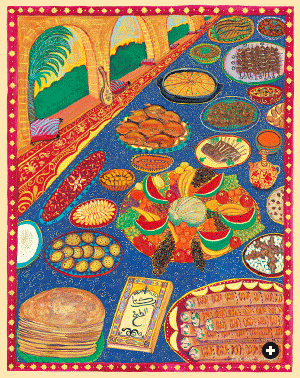 Written by Charles Perry
Written by Charles Perry
Illustrated by Linda Sawaya
 little over a thousand years ago, an Arab scribe wrote a book he titled Kitab al-Tabikh (The Book of Recipes). It was a collection of recipes from the court of ninth-century Baghdad, for the scribe’s unnamed patron—probably Saif al-Dawlah Al-Hamdani, the culture-minded prince of 10th-century Aleppo—had specifically asked him for the recipes of “kings and caliphs and lords and leaders.” The scribe, Abu Muhammad al-Muzaffar ibn Sayyar, was in a position to oblige, being descended from the old Muslim aristocracy himself.
little over a thousand years ago, an Arab scribe wrote a book he titled Kitab al-Tabikh (The Book of Recipes). It was a collection of recipes from the court of ninth-century Baghdad, for the scribe’s unnamed patron—probably Saif al-Dawlah Al-Hamdani, the culture-minded prince of 10th-century Aleppo—had specifically asked him for the recipes of “kings and caliphs and lords and leaders.” The scribe, Abu Muhammad al-Muzaffar ibn Sayyar, was in a position to oblige, being descended from the old Muslim aristocracy himself.
The book has come down to our time in three manuscripts and fragments of a fourth—and what a treasure it is. These are the dishes actually eaten by the connoisseurs of Baghdad when it was the richest city in the world. There are recipes from the personal collections of every caliph from al-Mahdi (died 785) to al-Mutawakkil (died 861), including 20 from Harun al-Rashid’s son al-Ma’mun. Thirty-five of the recipes—nearly one-tenth of the non-medicinal dishes in the book—come from Harun’s brother, the famous poet and gourmet Ibrahim ibn al-Mahdi.
This was the golden age of medieval cookery; centuries later, cookbooks would still carry recipes named for these very men: haaruuniyyah, ma‘muuniyyah, mutawakkiliyyah, ibraahimiyyah. A dish named for Ma’mun’s wife, buraniyyah, lives on today.
But Kitab al-Tabikh includes scarcely any of the familiar dishes of the modern Arab world. There’s no hummus or tabouli, no stuffed grape leaves, no kibbe, no baklava. Many dishes have strange, clanking medieval names like bazmaawurd, kardanaaj, isfiidhabaaj and diikbariika.
It was a heavily Persianized cuisine, but the dishes are not those of modern Iran either. There isn’t a single pilaf recipe, for example. What we see in this book is the royal cuisine of sixth- and seventh-century Iran along with a wealth of new dishes created under its influence by the chefs of Baghdad.
This was inevitable. Pre-Islamic Arabia had a wholesome but monotonous diet that revolved around dates, barley and dairy products. There were separate Arabic words for fresh dates mixed with milk (majii’), dried dates steeped in milk (siq‘al), pitted dates kneaded with milk (watii’ah) and pounded dates moistened with milk (wajii‘ah). When the Arabs conquered Persia, they found a sophisticated court with a rich and impressive cuisine, and they eagerly adopted Persian eating habits.
There had been a regular cult of gastronomy at the court of the Sassanian kings. A sixth-century Persian book entitled “The Story of King Khusraw and His Page” tells of a young nobleman who asks for a place in the king’s retinue on the grounds that he knows the best and choicest of everything. The king questions him on a host of subjects, mostly concerning food. In effect, the story is a handbook of fashionable gourmet opinions for a society where knowing such things was de rigueur.
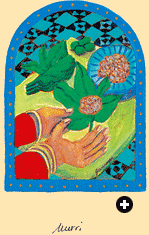 Kitab al-Tabikh contains anecdotes about cooking contests organized by the Persian kings. We know that the Abbasid caliphs later did the same. And “The Story of King Khusraw and His Page” was eventually translated into Arabic with many details intact, such as the fattening of chickens on hemp seed.
Kitab al-Tabikh contains anecdotes about cooking contests organized by the Persian kings. We know that the Abbasid caliphs later did the same. And “The Story of King Khusraw and His Page” was eventually translated into Arabic with many details intact, such as the fattening of chickens on hemp seed.
The centerpiece of ninth-century Baghdadi cuisine was rich and complex stews, often cooked in the tannuur (tandoor oven). Some had Persian names, such as sikbaaj (which was flavored with vinegar) and naarbaaj (flavored with pomegranate juice). The dishes with Arabic names, presumably developed in Baghdad, were often named after the main ingredient; for example, ‘adasiyyah (lentils with meat) and shaljamiyyah (with turnips). Some were named for aristocrats, such as haaruuniyyah (containing ground sumac, clearly one Harun al-Rashid’s favorite spices, because it appears in several of his recipes in Kitab al-Tabikh). A few stews have fantasy names. Narjisiyyah was topped with an egg, giving it the appearance of a narcissus flower—at least, if you really yearned to see the resemblance.
 |
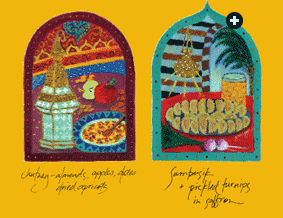 |
The dishes in this book call for a wide range of spices, including some little used in many Arab countries today, such as caraway (highly popular in the ninth century), the garlic-like asafetida, and galangal, a root which tastes like a cross between ginger and mustard. Fair enough: Everybody knows medieval food was heavily spiced. What’s more surprising is the lavish use of herbs in these recipes—sometimes five or more herbs in a single dish, including basil and tarragon as well as the usual mint, parsley and cilantro of modern Arab cookery. Many stews are sprinkled with the bitter, plum-scented herb rue just before serving. Even more surprising, many medieval stews call for cheese to be thrown in at some point.
The most unexpected flavoring is murri. This was made by wrapping lumps of barley dough in fig leaves so that they would be attacked by mold, then mixing the moldy barley with flour, salt and water and allowing it to ferment for another month or more. The rotted barley paste would then be pressed to yield a dark-brown liquid which turns out to taste just like soy sauce. This whiff of soy ran through the food of the caliphs. The Arab sauce was not borrowed from China, however: Murri was never made from beans and it was always a liquid sauce, while the Chinese product was used as a paste until the 16th century.
People must often have cooked skewers of meat over an open charcoal fire in the ninth century, as they do today, but in this book roast meat (shiwaa’) is always cooked in a tannuur. The meat wasn’t always cut small in the shish kebab manner; fairly large items were roasted in this way, such as stuffed kid and spice-crusted rack of lamb (janb mubazzar).
Fish were cooked in the tannur too. Kitab al-Tabikh gives an ingenious recipe for a fish “whose head is roasted, whose middle is baked and whose tail is fried” which later appeared in medieval European cookbooks. (The middle of the fish was wrapped in several layers of cloth and the tail was wrapped in oil-soaked canvas.) It must have seemed as astonishing in the ninth century as baked Alaska would a thousand years later.
The supreme roast meat dish was juudhaab (or juudhaabah), where the meat was served on a sweet pudding which had been baked at the bottom of the tannur to catch its dripping juices. In the wickedly funny story known as the Maqamah of Baghdad, the 10th-century writer Badi’ al-Zaman al-Hamathani shows a rascal tricking a peasant into buying him a juuthaab dinner from one of the specialists in the market.
Fried meat was popular, of course, but fried dishes were less impressive and dignified than roasts and stews. Frying was often done in a smaller version of the qidr, the shallow pot used for stews. It was made of carved soapstone, like the miqlah of modern Yemen. Dishes containing eggs, such as narjiliyyah and ‘ujjah, a rather solid “omelette” which is still popular in the Arab world, were also fried in soapstone utensils.
There was no bulgur wheat, and the pilaf technique of cooking rice by boiling and then steaming was unknown. Rice and wheat were often cooked in the tannuur overnight with meat and spices to make a sort of meaty porridge (aruzziyyah, hintiyyah). If the wheat was beaten to a smooth paste, you had hariisah, a dish still widely made in the Middle East.
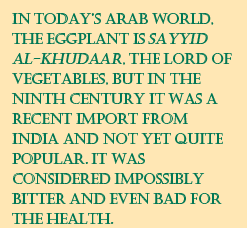 |
 |
Noodles were usually cooked in soup. The book recounts a quite unbelievable story of their supposed invention by the sixth-century Persian king Khusraw Anushirwan: He offhandedly tells his cook to throw “some pieces of dough” into his soup. The book’s word for noodles, lakhshaa, is now extinct in both Arabic and Persian, though it has entered European languages from Hungarian to Russian. For that matter, the book calls soup maa’-wa-milh (“water-and-salt”), a fairly literal translation of the Persian shorbaa (“salty stew”), because the word shorbaa had not yet entered Arabic.
The book gives only a few vegetarian dishes, called muzaw-waraat (literally, “counterfeit” dishes, which reminds us of the Turkish name for vegetables with a meatless stuffing: yalanci dolma, “lying dolma”). They were known as the dishes that Christians ate on fast days, and they were thought to be good for the health—and they had indeed been introduced by the Nestorian Christian physicians favored by the caliphs. There were also cold dishes, sometimes vegetable-based but more often containing meat, called baaridah. Some of them are probably descended from the pre-Islamic Persian dishes called aamiz.
It comes as a surprise that eggplant shows up so rarely in these recipes. In today’s Arab world, it is sayyid al-khudaar, the lord of vegetables, but at the time it was a recent import from India and not yet quite popular. It was considered impossibly bitter; in a widely repeated anecdote, a Bedouin declared that eggplant had “the color of a scorpion’s belly and the taste of a scorpion’s sting.” It was actually considered bad for the health. Doctors blamed it for everything from freckles and a hoarse throat to cancer and madness.
 |
 |
Still, there are seven eggplant baaridah in this book, probably because a taste for eggplant first arose among the aristocracy. Two of the dishes are called baadhinjaan buran, “the eggplant of Buran,” after al-Ma’mun’s wife, whose month-long wedding party was a medieval byword for luxury. Today a vast range of dishes called burani or buraniyyah are made everywhere from Spain to India. The recipes in Kitab al-Tabikh, dating from only 50 or 60 years after her death, must be very close to the originals. One is simply fried eggplant slices sprinkled with murri, pepper and caraway. It’s rather good.
Some foods, such as bread and roasted meats, were felt to be excessively plain by themselves, so they were served with sauces or condiments. A condiment for meat or fish was called a sibaagh. It was something like an Indian fresh chutney, usually including a sour ingredient, a dried fruit, crushed nuts—or all three—as well as herbs and spices.
For bread, there was a whole range of condiments or dips called kaamakh. In modern Arabic, this word is sometimes used for vinegar pickles, but the main ninth-century condiment, al-kaamakh al-ahmar, was made by mixing fermented barley —the same material that murri was made of—with milk and salt. The mold quickly gives the milk the flavor of a blue cheese. In fact, blue cheese is made much the same way, by mixing moldy bread with fresh cheese curd.
The difference between blue cheese and al-kaamakh al-ahmar (apart from color: al-kaamakh al-ahmar is a dark reddish brown) is that the Arab condiment wasn’t curdled and pressed to remove moisture, which is what allows cheese to resist spoilage. Al-kaamakh al-ahmar was preserved by its salt. It smelled and tasted like a pungent, salty blue cheese and had a spreadable consistency. It could be used as it was, but Kitab al-Tabikh also gives a dozen recipes for flavoring it with various herbs and spices.
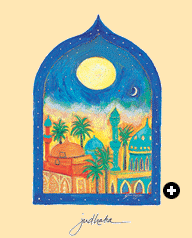 |
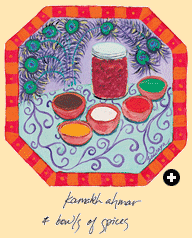 |
Finally, the book gives 90 recipes for sweets. Some are still known today, such as zulaabiyyah, a fritter made by pouring batter into hot oil, and qataa’if, crepes folded around a filling of ground nuts and then deep-fried. Naatif was a sweet made from beaten egg whites. Muhallabiyyah was a pudding sometimes thickened with rice flour, like the present-day version, but sometimes with eggs or noodles, and it might contain chicken meat. There were 38 recipes for khabiisah, a flour-thickened pudding flavored with nuts, dried fruits or even carrots.
But other desserts are unfamiliar. Khushkanaanaj was a sort of cookie or sweet biscuit. The most esteemed sweet was lauziinaq, an almond paste much like marzipan—probably the ancestor of marzipan, in fact. In its most admired form, it was rolled into finger shapes, wrapped in paper-thin crepes and “drowned” in syrup.
The gourmets of ninth-century Baghdad would certainly have appreciated modern sweets like baklava, but they were justly enthralled by the glory of their own cuisine. Among the 90-odd poems about food scattered through this book, many reflect a passionate fascination with these rich and impressive dishes, including this heartfelt praise for a juthabah by the 10th-century poet Kushajam:
A juudhaabah of excellent semolina, as pallid as a lovesick face,
A shining wonder from the hand of an able cook,
The well-done meat as rosy as dates made by the Creator,
With sugar of Ahwaz sweeter than a night visitor,
Drowning in fat, trembling, it diffuses aroma to the taster.
As soft as butter to the touch, its perfume like finest ambergris.
It gleams in its bowl like a star in the dark of night
Or a bright yellow carnelian on the clear cheek of a tender girl,
Sweeter than peace coming in the depths of night
To a throbbing, anguished heart.
 |


 This giant canapé was the traditional first course at a banquet in pre-Islamic Iran or Abbasid Baghdad. The name comes from the Persian bazm, “banquet,” and awurd, “bringing.” The recipe given here is from the collection of the Caliph al-Ma’mun. It calls for the flesh of citron, a fruit with very little flesh—we know it mostly for its candied peel. Lemon is an obvious substitute. This giant canapé was the traditional first course at a banquet in pre-Islamic Iran or Abbasid Baghdad. The name comes from the Persian bazm, “banquet,” and awurd, “bringing.” The recipe given here is from the collection of the Caliph al-Ma’mun. It calls for the flesh of citron, a fruit with very little flesh—we know it mostly for its candied peel. Lemon is an obvious substitute.
1 lavash, Mexican flour tortilla or other fresh thin flatbread
about 12" diameter
1 whole chicken breast, roasted, boned and chopped
2 tablespoons chopped walnuts
1½ to 2 lemons, peeled, seeded and chopped
1 tablespoon minced fresh tarragon
1 tablespoon chopped mint
2 tablespoons chopped basil
Spread flatbread on work surface. Sprinkle evenly all over with chicken, walnuts, chopped lemon, tarragon, mint and basil. Roll up and cut into 4 slices. Warm in oven before serving. Serves four as an appetizer.

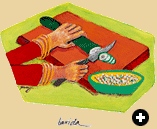 A baaridah was a cold meat or vegetable dish served before the hot dishes. Following pre-Islamic Iranian tradition, when a baaridah was made with fowl, it was usually a sort of chopped cucumber salad garnished with the roast meat. Some recipes call for only the seeds of cucumbers, which makes for a luxurious, slippery texture. This particular recipe is that of Harun’s famous vizier, Yahya ibn Khalid al-Barmaki. Verjuice, the juice of sour grapes, is sold in Middle Eastern markets as abghureh or hisrmi. If you can’t find it, lemon juice will do. A baaridah was a cold meat or vegetable dish served before the hot dishes. Following pre-Islamic Iranian tradition, when a baaridah was made with fowl, it was usually a sort of chopped cucumber salad garnished with the roast meat. Some recipes call for only the seeds of cucumbers, which makes for a luxurious, slippery texture. This particular recipe is that of Harun’s famous vizier, Yahya ibn Khalid al-Barmaki. Verjuice, the juice of sour grapes, is sold in Middle Eastern markets as abghureh or hisrmi. If you can’t find it, lemon juice will do.
1 whole chicken breast, roasted
1 teaspoon coriander
½ teaspoon pepper
¼ teaspoon cumin
⅛ teaspoon cinnamon
¼ cup verjuice or lemon juice
1 teaspoon minced fresh mint
2 teaspoons minced fresh tarragon
1 teaspoon minced fresh thyme
2 tablespoons olive oil
salt
1 cucumber, peeled and cut in ¼-inch dice
When chicken is cool, remove skin and bones, and tear meat into small pieces. Place in bowl and add coriander, cumin, pepper, cinnamon, verjuice, mint, tarragon, thyme and oil. Mix well and season to taste with salt. To serve, mound chicken on salad plates and surround with chopped cucumbers. Serves two.

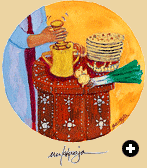 Mulahwajah means “hasty.” The book says that this recipe was often prepared for Harun al-Rashid. Galangal is sold in Arabia as ‘irq al-hail or khulanjan, and in Southeast Asian markets under such names as kha and laos. Dried ginger could be substituted. Use the rue sparingly—it’s very bitter. Mulahwajah means “hasty.” The book says that this recipe was often prepared for Harun al-Rashid. Galangal is sold in Arabia as ‘irq al-hail or khulanjan, and in Southeast Asian markets under such names as kha and laos. Dried ginger could be substituted. Use the rue sparingly—it’s very bitter.
2 tablespoons oil
1 onion
2 leeks
rue, preferably fresh
cilantro (green coriander, kuzbarah)
½ pound lamb, chopped or ground
2 teaspoons ground coriander seed
½ teaspoon cinnamon
1 teaspoon ground caraway
1 teaspoon ground pepper
1 teaspoon ground galangal
4 teaspoons vinegar
2 tablespoons soy sauce
2 tablespoons honey
Heat oil in pan. Add onion, leeks, pinch of rue and 2 to 3 sprigs cilantro and fry until soft. Add meat and fry until brown. Add coriander, caraway, pepper, galangal, vinegar and soy sauce. Cook until done. Stir in honey and garnish with several more sprigs cilantro. Serve with flatbread. Serves two.

 This recipe, from the manuscript of Yahya ibn Khalid al-Barmaki, makes striking use of murri, the indigenous Middle Eastern barley “soy sauce.” Most dishes flavored with murri were vinegary, but this is the exception, being quite sweet. The result is surprisingly reminiscent of a Chinese “red-stewed” meat dish. The name comes from the Persian word for frying pan, tavah. This recipe, from the manuscript of Yahya ibn Khalid al-Barmaki, makes striking use of murri, the indigenous Middle Eastern barley “soy sauce.” Most dishes flavored with murri were vinegary, but this is the exception, being quite sweet. The result is surprisingly reminiscent of a Chinese “red-stewed” meat dish. The name comes from the Persian word for frying pan, tavah.
½ cup soy sauce
5 teaspoons honey
¾ teaspoon ground coriander seed
1 rounded teaspoon cinnamon
⅛ teaspoon pepper
2 pounds boneless lamb shoulder
½ cup oil
cilantro (green coriander, kuzbarah)
rue, preferably fresh, optional
mustard greens, optional
Mix soy sauce, honey, ground coriander, cinnamon and pepper. Add meat and marinate half an hour. Heat oil in large frying pan. When hot, spoon in meat and marinade. Reduce heat to medium-low and cover pan loosely for half an hour. Remove lid and cook, stirring often to prevent scorching, until meat is tender and sauce is reduced to a thick glaze. Pour off oil and serve, sprinkled with cilantro, rue and mustard greens, accompanied by flatbread. Serves four.

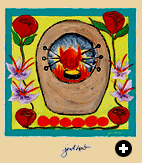 This favorite dish of medieval Baghdad consisted of a sweet pudding which was set at the
bottom of a tannuur oven to catch the juices of roasting meat, which would be served with
the pudding. Here we have a recipe from the collection of Caliph al-Wathiq (842–847). This favorite dish of medieval Baghdad consisted of a sweet pudding which was set at the
bottom of a tannuur oven to catch the juices of roasting meat, which would be served with
the pudding. Here we have a recipe from the collection of Caliph al-Wathiq (842–847).
1 chicken
¼ cup plus 2 tablespoons rosewater
ground saffron
1 pound dried apricots
2 fresh lavashes, Mexican flour tortillas or other flatbreads, 12" in diameter
½ cup sugar
Wash chicken and pat dry. Mix 2 tablespoons rosewater with pinch of saffron and rub on chicken, inside and out. Set chicken on high rack in 350-degree oven. Put apricots in small saucepan, add water to cover apricots by ½ inch and stew until softened. Place one lavash in baking pan. Arrange stewed apricots on top, sprinkle with sugar and ¾ cup rosewater in which pinch of saffron has been dissolved, then cover with remaining lavash. When juices begin running from chicken, set baking pan under it to catch juices. When chicken is done, serve on apricot pudding. Serves four.
|
 |
Charles Perry (charles.perry@latimes.com) studied at Princeton University, the University of California and the Middle East Center for Arab Studies, Shimlan, Lebanon. Today a food writer for The Los Angeles Times, he has written widely on food history and recently published a fresh translation of al-Baghdadi’s 13th-century cookbook (A Baghdad Cookery Book, Prospect Books, 2005). |
 |
Linda Dalal Sawaya is an artist, writer and illustrator who lives in Portland, Oregon. She is the author of Alice’s Kitchen: Traditional Lebanese Cooking, featured in the 1997 Aramco World article “Memories of a Lebanese Garden.”
|